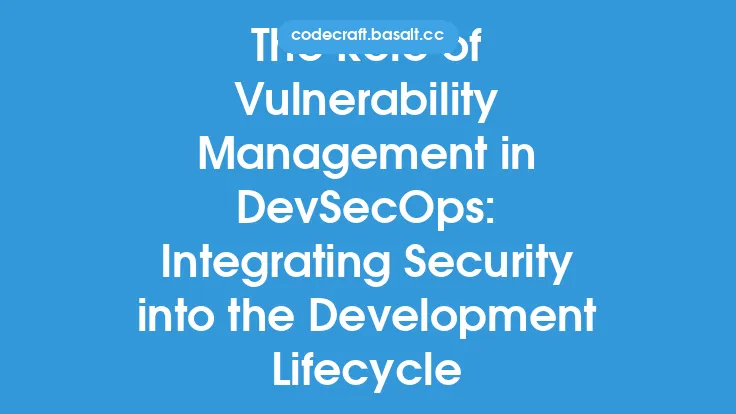The success of vulnerability management in any organization heavily relies on the human factor, particularly within development teams. While technology and automated tools play a crucial role in identifying and remediating vulnerabilities, the knowledge, awareness, and actions of developers and other team members are equally, if not more, critical. Training and awareness programs tailored for development teams are essential components of a comprehensive vulnerability management strategy. These programs not only enhance the security posture of an organization but also foster a culture of security awareness and responsibility among team members.
Importance of Training in Vulnerability Management
Training is a foundational element in equipping development teams with the necessary skills and knowledge to manage vulnerabilities effectively. It encompasses a wide range of topics, from secure coding practices and vulnerability identification to remediation strategies and compliance with security standards. Effective training programs should be designed to address the specific needs and roles within the development team, ensuring that each member understands their responsibilities and how their actions impact the overall security of the software or system.
Moreover, training should not be a one-time event but rather an ongoing process. The cybersecurity landscape is constantly evolving, with new vulnerabilities and threats emerging daily. Regular training sessions and updates help development teams stay abreast of the latest security threats, technologies, and best practices. This continuous learning approach enables teams to adapt quickly to changing security requirements and to integrate security into every phase of the development lifecycle.
Awareness and Its Role in Vulnerability Management
Awareness is closely tied to training but focuses more on creating a mindset and culture within the organization where security is everyone's responsibility. Awareness programs aim to educate development teams about the potential risks and consequences of vulnerabilities, the importance of security in the development process, and how individual actions can impact the security posture of the organization. By fostering a security-aware culture, organizations can encourage proactive behavior among team members, such as reporting potential security issues, suggesting security improvements, and adhering to secure development practices.
Awareness programs can take many forms, including workshops, seminars, newsletters, and even gamification. The key is to keep the content engaging, relevant, and accessible to all team members, regardless of their technical background. For instance, a security awareness campaign might highlight common vulnerabilities, demonstrate how vulnerabilities can be exploited, and provide tips on secure coding practices. By making security awareness a part of daily operations, organizations can significantly reduce the risk of vulnerabilities being introduced into their software and systems.
Technical Skills for Effective Vulnerability Management
Development teams require a set of technical skills to manage vulnerabilities effectively. These skills include the ability to write secure code, understand common web application vulnerabilities (such as SQL injection and cross-site scripting), and know how to use security testing tools. Moreover, knowledge of secure development lifecycle models, such as Microsoft's Security Development Lifecycle (SDL), can help teams integrate security into every phase of development, from design to deployment.
Technical training should also cover the use of vulnerability scanning and management tools, which are crucial for identifying and prioritizing vulnerabilities. Understanding how to interpret scan results, prioritize vulnerabilities based on risk, and apply patches or fixes is essential for effective vulnerability management. Additionally, teams should be familiar with compliance standards and regulations relevant to their industry, such as PCI DSS for payment card information or HIPAA for healthcare data, to ensure that their vulnerability management practices meet legal and regulatory requirements.
Implementing Training and Awareness Programs
Implementing effective training and awareness programs for development teams requires careful planning and execution. First, organizations should conduct a needs assessment to identify knowledge gaps and areas where training is most needed. This assessment can involve surveys, interviews with team members, and reviews of current security practices and incidents.
Next, organizations should develop a comprehensive training plan that includes both technical skills training and security awareness programs. The plan should outline learning objectives, training methods (such as classroom training, online courses, or mentoring), and how progress will be measured. It's also important to ensure that training programs are engaging and relevant to the team's work, using real-world examples and scenarios to illustrate key concepts.
Finally, organizations should establish metrics to evaluate the effectiveness of their training and awareness programs. This could include tracking the number of vulnerabilities reported and fixed, conducting regular security audits, and monitoring compliance with security policies and standards. Feedback from team members is also crucial, as it can help identify areas for improvement in the training programs and ensure that they continue to meet the evolving needs of the development team.
Conclusion
In conclusion, the human factor plays a critical role in vulnerability management, and training and awareness programs are essential for equipping development teams with the knowledge and skills needed to manage vulnerabilities effectively. By combining technical training with security awareness programs, organizations can foster a culture of security responsibility and significantly reduce the risk of vulnerabilities in their software and systems. As the cybersecurity landscape continues to evolve, the importance of ongoing training and awareness will only continue to grow, making it a vital investment for any organization committed to protecting its digital assets.





